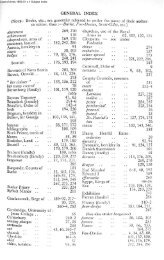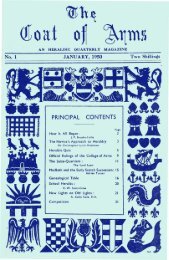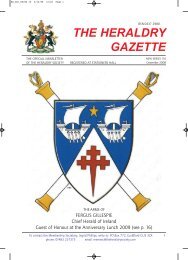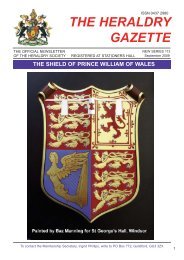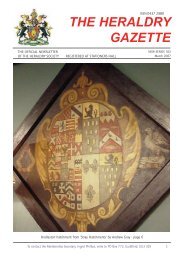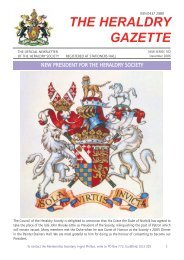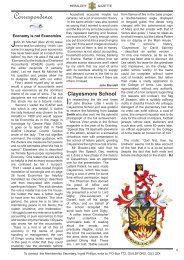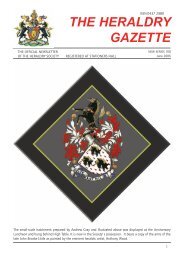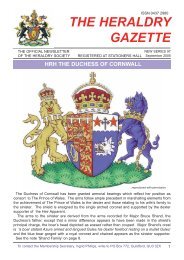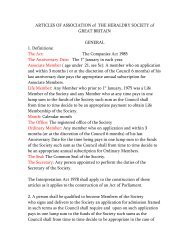Mar-06 Issue - The Heraldry Society
Mar-06 Issue - The Heraldry Society
Mar-06 Issue - The Heraldry Society
Create successful ePaper yourself
Turn your PDF publications into a flip-book with our unique Google optimized e-Paper software.
2<br />
CRANWELL HERALDRY PART THREE: UNIT BADGES<br />
<strong>The</strong> Badge of Royal Air<br />
Force Cranwell is quite distinct<br />
from the coat of arms of the<br />
Royal Air Force College. <strong>The</strong><br />
station badge was approved<br />
by George VI, in September<br />
1948. It depicts an eagle on a<br />
rock, and bears the motto<br />
Alitum Altrix, which translates<br />
as, “Nurture the Winged”. <strong>The</strong><br />
motto alludes to the unit's role<br />
in support of the College,<br />
when the flight cadets<br />
underwent pilot training,<br />
before they graduated. <strong>The</strong><br />
eagle is not only symbolic, it is<br />
derived from the bronze<br />
sculpture which was<br />
presented to the College by<br />
Sir Philip Sassoon in 1933,<br />
and forms the support for the<br />
Queen's Colour in the dining<br />
room of College Hall.<br />
Unit badges were not<br />
formally recognized until the<br />
appointment of the Inspector<br />
of RAF Badges was created in<br />
<strong>Mar</strong>ch 1935. It was then that<br />
a standard frame for all<br />
badges was designed. <strong>The</strong><br />
imperial crown would<br />
surmount a circlet which would<br />
accommodate the unit's<br />
Officer and Aircrew<br />
Cadet Training Unit<br />
description, and the unit's<br />
choice of an emblem or<br />
insignia would be placed in the<br />
centre. <strong>The</strong> circlet would then<br />
be mounted on a scroll which<br />
contained the unit's motto.<br />
This year, four Cranwell units<br />
brought new or dormant<br />
badges into use. <strong>The</strong> first use<br />
came about when the<br />
Department of Initial Officer<br />
Training began to train noncommissioned<br />
aircrew.<br />
Although still a part of the<br />
Royal Air Force College, the<br />
department had long been<br />
eligible for a unit badge, and it<br />
was decided that the design<br />
should be based on that of the<br />
Officer Cadet Training Unit,<br />
which had been disbanded at<br />
Henlow. Its badge had been<br />
approved in October 1947,<br />
No 674 Squadron<br />
Army Air Corps<br />
No 703 Royal Naval<br />
Air Squadron<br />
and depicted a knight's spur,<br />
with the motto 'Majora Tento',<br />
“I aim at greater things”. An<br />
application was therefore<br />
made for a 'near copy' of the<br />
original, with the unit name<br />
changed to Officer and<br />
Aircrew Cadet Training Unit.<br />
<strong>The</strong> badge was approved by<br />
the Air Member for Personnel,<br />
in June 2003. <strong>The</strong> second unit<br />
was the Department of<br />
Elementary Flying Training,<br />
which was re-designated No 1<br />
Elementary Flying Training<br />
School and assumed the<br />
badge which that unit had<br />
been granted, in November<br />
1944. Appropriately, the motto<br />
is 'Ab Initio', “From the<br />
Beginning”, and the emblem is<br />
the chrysalis and moth of the<br />
tiger moth: the de Havilland<br />
Tiger Moth being extensively<br />
used as a training aircraft<br />
during the Second World War.<br />
<strong>The</strong> army and navy elements<br />
of No 1 Elementary Flying<br />
Training School then became<br />
badged units, as No 674<br />
Squadron Army Air Corps and<br />
No 703 Royal Naval Air<br />
Squadron.<br />
No 1 Elementary<br />
Flying Training School<br />
Items for inclusion in the Gazette post to: <strong>The</strong> Editor, <strong>The</strong> <strong>Heraldry</strong> Gazette, at the<br />
address given on page 9, or e-mail to: gazette@theheraldrysociety.com



